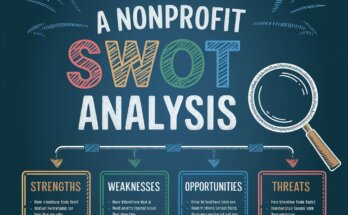In the fast-paced world of nonprofits, where every dollar counts and every decision impacts lives, having a clear roadmap is essential. This is where strategic planning comes into play. Nonprofits need strategic planning to define their direction, allocate resources efficiently, and ultimately achieve their mission.
In this blog post, we will explore why strategic planning is vital for nonprofits, the benefits it brings, and how organizations can implement effective strategies.
Understanding Strategic Planning
At its core, strategic planning is the process of outlining an organization’s long-term goals and determining the best ways to achieve them.
For nonprofits, this involves not just envisioning a better future but also creating a practical plan to make that vision a reality. This plan encompasses everything from setting objectives to evaluating progress and making necessary adjustments.
Imagine a nonprofit organization dedicated to improving literacy rates among children in underserved communities. Without a strategic plan, their efforts may be scattered, lacking focus and direction.
However, with a strategic plan, they can identify specific literacy programs, target demographics, and set measurable goals to track their progress. This approach ensures that their resources are utilized effectively and that they are making a meaningful impact.
The Benefits of Strategic Planning for Nonprofits
1.Clarity and Focus: One of the primary benefits of strategic planning is that it provides clarity and focus. Nonprofits often juggle multiple projects and initiatives, which can lead to confusion and wasted resources. A well-defined strategic plan helps organizations prioritize their efforts, ensuring everyone is on the same page.
Example: Consider a nonprofit that provides food assistance. Without strategic planning, they might try to address hunger in various ways—food distribution, nutrition education, and community gardening—without clear priorities. With a strategic plan, they can focus on the most pressing need, such as expanding their food distribution efforts in the areas with the highest demand.
2. Better Resource Allocation: Resources—whether financial, human, or time—are often limited in the nonprofit sector. Strategic planning allows organizations to allocate these resources more effectively. By identifying key priorities and aligning resources accordingly, nonprofits can maximize their impact.
Example: A nonprofit focused on mental health services might have a limited budget. Through strategic planning, they can identify which programs are most effective in reaching their target audience and allocate funds accordingly, perhaps prioritizing community outreach over additional training for existing staff.
3. Enhanced Communication: Strategic planning fosters better communication both internally among staff and externally with stakeholders. When everyone understands the organization’s goals and strategies, it becomes easier to collaborate and coordinate efforts.
Example: A nonprofit that serves individuals with disabilities can benefit from strategic planning by clearly communicating their mission and goals to volunteers and partners. This ensures that everyone involved understands the organization’s objectives and can work together towards common goals.
How to Implement Strategic Planning
1. Define Your Mission and Vision
Before diving into the specifics of strategic planning, it’s crucial to have a clear mission and vision statement. The mission defines the organization’s purpose, while the vision outlines what success looks like in the future.
Example: The mission of a nonprofit might be, “To empower underprivileged youth through education and mentorship.” The vision could be, “A world where all young people have access to quality education and the support they need to succeed.”
2. Conduct a SWOT Analysis
A SWOT analysis (Strengths, Weaknesses, Opportunities, Threats) is an essential step in strategic planning. This analysis helps nonprofits identify their internal strengths and weaknesses while also considering external opportunities and threats.
Example: In our literacy nonprofit, strengths might include a dedicated volunteer base, while weaknesses could be limited funding. Opportunities might involve partnerships with local schools, and threats could include competition from other organizations.
3. Set SMART Goals
Once the organization understands its current position, it’s time to set SMART goals—Specific, Measurable, Achievable, Relevant, and Time-bound. These goals provide a clear framework for what the organization aims to achieve.
Example: Instead of stating, “We want to improve literacy,” a SMART goal would be, “We will increase the number of children reading at grade level by 20% within two years.”
4. Develop Action Plans
With SMART goals in place, nonprofits need to create action plans outlining how they will achieve these objectives. This includes identifying who is responsible for each task, the resources needed, and a timeline for completion.
Example: For the literacy nonprofit, an action plan might include conducting reading workshops at local schools, recruiting volunteer tutors, and securing funding for books and materials.
5. Monitor and Evaluate Progress
Strategic planning is not a one-time event; it’s an ongoing process. Regularly monitoring and evaluating progress allows nonprofits to stay on track and make necessary adjustments. This could involve quarterly reviews or annual assessments of goals and outcomes.
Example: The literacy nonprofit could assess its reading programs every six months, analyzing the number of students served and their reading improvement. If goals are not being met, adjustments can be made, such as changing the tutoring methods or expanding outreach efforts.
The Story of Empowerment
Let’s take a moment to reflect on a real-life story that illustrates the power of strategic planning in nonprofits.
The Case of “Read to Succeed”
“Read to Succeed” is a nonprofit dedicated to improving literacy rates among children in low-income neighborhoods. They started with a handful of volunteers and a passion for making a difference. However, despite their dedication, they struggled to make a significant impact due to a lack of direction and resources.
Realizing they needed a more structured approach, they decided to implement strategic planning. They defined their mission: “To empower children through literacy.” They conducted a SWOT analysis, discovering their strengths in community engagement but weaknesses in funding. They set SMART goals, including increasing literacy rates among participating children by 30% within three years.
With a clear action plan in place, they began recruiting more volunteers, establishing partnerships with local schools, and seeking grants. They monitored their progress regularly, adjusting their strategies as needed.
Three years later, “Read to Succeed” not only met their goal but exceeded it, improving literacy rates by 40%. Their success was not just about numbers; it transformed the lives of countless children, giving them the tools they needed for a brighter future.
This story exemplifies how nonprofits can leverage strategic planning to navigate challenges, enhance their impact, and ultimately fulfill their mission.
Overcoming Challenges in Strategic Planning
While the benefits of strategic planning are clear, nonprofits may face challenges during the process. Here are some common obstacles and ways to overcome them:
- Limited Resources: Many nonprofits operate on tight budgets. To address this, organizations can seek grants specifically for strategic planning initiatives or collaborate with other nonprofits to share resources.
- Resistance to Change: Change can be daunting. To mitigate this, involve staff and stakeholders in the planning process. By soliciting input and feedback, everyone feels more invested in the outcome.
- Time Constraints: With daily operations demanding attention, finding time for strategic planning can be tough. Consider setting aside dedicated time for planning sessions or incorporating strategic discussions into regular staff meetings.
Taking Action
Nonprofits need strategic planning to define their goals, allocate resources effectively, and enhance their overall impact. By embracing a structured approach, organizations can navigate challenges, improve communication, and work towards a shared vision.
Are you ready to take your nonprofit to the next level? Subscribe to the Nonprofit Navigators Newsletter for more expert tips and resources tailored to nonprofits. Gain access to job opportunities, grant opportunities, exclusive webinars, events, and much more!
Additionally, don’t miss out on our Strategic Planning Guide for Nonprofits, which offers comprehensive insights and practical tools to help you develop an effective strategic plan.
By investing in strategic planning, your nonprofit can create a lasting impact and drive meaningful change in your community.




